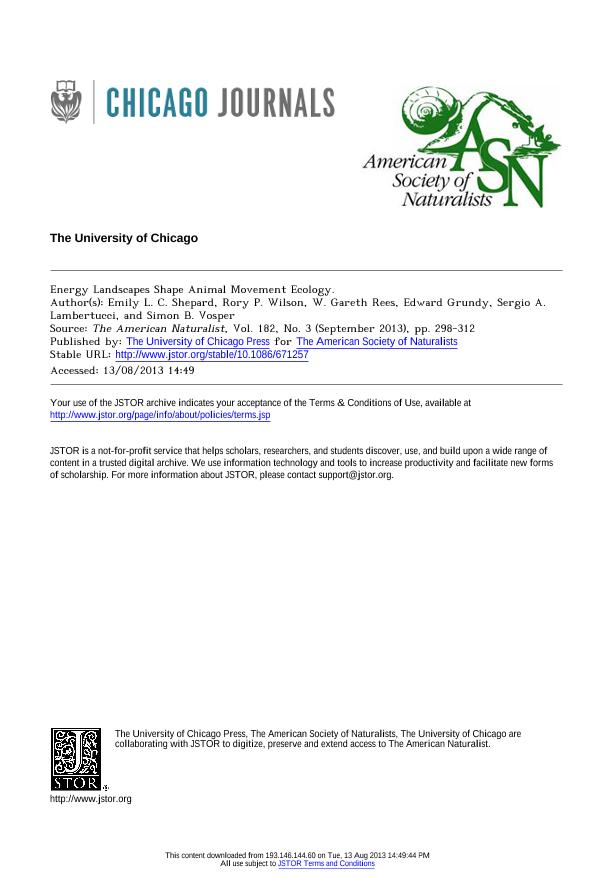Mostrar el registro sencillo del ítem
dc.contributor.author
Shepard, Emily L. C.
dc.contributor.author
Wilson, Rory P.
dc.contributor.author
Rees, W. Gareth
dc.contributor.author
Grundy, Edward
dc.contributor.author
Lambertucci, Sergio Agustin

dc.contributor.author
Vosper, Simon B.
dc.date.available
2016-07-28T17:55:44Z
dc.date.issued
2013-09
dc.identifier.citation
Shepard, Emily L. C.; Wilson, Rory P.; Rees, W. Gareth; Grundy, Edward; Lambertucci, Sergio Agustin; et al.; Energy landscapes shape animal movement ecology; University Of Chicago Press; American Naturalist; 182; 3; 9-2013; 298-312
dc.identifier.issn
0003-0147
dc.identifier.uri
http://hdl.handle.net/11336/6755
dc.description.abstract
The metabolic costs of animal movement have been studied extensively under laboratory conditions, although frequently these are a poor approximation of the costs of operating in the natural, heterogeneous environment. Construction of “energy landscapes,” which relate animal locality to the cost of transport, can clarify whether, to what extent, and how movement properties are attributable to environmental heterogeneity. Although behavioral responses to aspects of the energy landscape are well documented in some fields (notably, the selection of tailwinds by aerial migrants) and scales (typically large), the principles of the energy landscape extend across habitat types and spatial scales. We provide a brief synthesis of the mechanisms by which environmentally driven changes in the cost of transport can modulate the behavioral ecology of animal movement in different media, develop example cost functions for movement in heterogeneous environments, present methods for visualizing these energy landscapes, and derive specific predictions of expected outcomes from individual- to population- and species-level processes. Animals modulate a suite of movement parameters (e.g., route, speed, timing of movement, and tortuosity) in relation to the energy landscape, with the nature of their response being related to the energy savings available. Overall, variation in movement costs influences the quality of habitat patches and causes nonrandom movement of individuals between them. This can provide spatial and/or temporal structure to a range of population- and species-level processes, ultimately including gene flow. Advances in animal-attached technology and geographic information systems are opening up new avenues for measuring and mapping energy landscapes that are likely to provide new insight into their influence in animal ecology.
dc.format
application/pdf
dc.language.iso
eng
dc.publisher
University Of Chicago Press

dc.rights
info:eu-repo/semantics/openAccess
dc.rights.uri
https://creativecommons.org/licenses/by-nc-sa/2.5/ar/
dc.subject
Energy Landscapes
dc.subject
Animal Movement
dc.subject
Cost of Transport
dc.subject
Biotelemetry
dc.subject.classification
Ecología

dc.subject.classification
Ciencias Biológicas

dc.subject.classification
CIENCIAS NATURALES Y EXACTAS

dc.title
Energy landscapes shape animal movement ecology
dc.type
info:eu-repo/semantics/article
dc.type
info:ar-repo/semantics/artículo
dc.type
info:eu-repo/semantics/publishedVersion
dc.date.updated
2016-07-22T18:51:31Z
dc.journal.volume
182
dc.journal.number
3
dc.journal.pagination
298-312
dc.journal.pais
Estados Unidos

dc.journal.ciudad
Chicago
dc.description.fil
Fil: Shepard, Emily L. C.. Swansea University; Reino Unido
dc.description.fil
Fil: Wilson, Rory P.. Swansea University; Reino Unido
dc.description.fil
Fil: Rees, W. Gareth. University of Cambridge; Reino Unido
dc.description.fil
Fil: Grundy, Edward. Swansea University; Reino Unido
dc.description.fil
Fil: Lambertucci, Sergio Agustin. Consejo Nacional de Investigaciones Científicas y Técnicas. Centro Científico Tecnológico Patagonia Norte. Instituto de Investigación en Biodiversidad y Medioambiente; Argentina
dc.description.fil
Fil: Vosper, Simon B.. Met Office; Reino Unido
dc.journal.title
American Naturalist

dc.relation.alternativeid
info:eu-repo/semantics/altIdentifier/url/http://www.journals.uchicago.edu/doi/10.1086/671257
dc.relation.alternativeid
info:eu-repo/semantics/altIdentifier/doi/10.1086/671257
dc.relation.alternativeid
info:eu-repo/semantics/altIdentifier/doi/http://dx.doi.org/10.1086/671257
Archivos asociados
